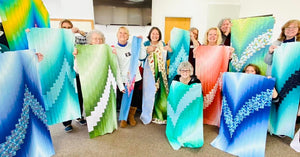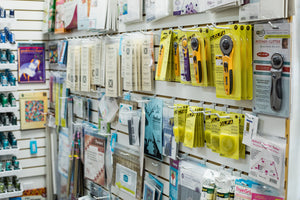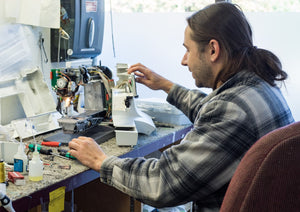Sewing Machine Maintenance 101
Why is cleaning your machine important?
Your sewing machine is an investment. Regular cleaning is a part of keeping your machine running great! Lint build-up in your sewing machine will happen naturally after countless hours of sewing. Clearing out and removing that lint is an important part of keeping everything running smoothly! Excessive lint, dirt and fibers over time can cause machine parts to bend, bind or break. Simply cleaning out accessible areas can help keep your machine running smoothly. But a good professional cleaning from the inside out will really prolong the life of your machine!
Canned or Compressed Air
You’ve probably seen canned air advertised as a quick solution to clean electronics – and it makes sense that a quick puff could remove debris from a computer keyboard. But the same is simply not true for your delicate sewing machine. Compressed air might make it look like you’ve removed the lint by blowing it off visible areas – but often – the lint has been compressed into areas of the machine which are more difficult to access. Since you do not want to compact lint deep into your machines interior, we do not recommend using canned or compressed air to clean your machines.
How do I properly clean my machine myself?
While sewing machine models differ, some basic procedures for cleaning and oiling are the same. Don’t forget to check in your sewing machine manual for specific directions to clean and oil your specific model. It is a good idea to take a moment before you begin to sew to simply wipe down the machine.
Make sure that the machine is off and remove the needle plate. Large pieces of lint, bits of thread or fibers can be removed with tweezers. Then use gentle brushes or a soft lamb’s wool tool to clear out any remaining bits. Rub the lamb’s wool tool back and forth over the surface and the dust will cling to it. When you are finished, shake the lamb’s wool tool out over a trash bin and knock the lint off it so it will be ready for next time. Then remove the bobbin case, take out the bobbin and use your soft brushes to clean out any lint or dirt from that area. Note that lint can actually get trapped in the tension spring on your bobbin case that can result in poor stitch quality.
Home Maintenance Tips from our Technicians
- Tip #1: A common culprit causing skipped stitches may be your sewing needle. Using an old or damaged needle can also cause broken thread or needle breakage. Changing your needle regularly is a good habit to develop.
- Tip #2: Be sure to have the presser foot up (raised) when threading your sewing machine. With the presser foot up, the tension disks are opened, which allows the thread to be seated properly between them. Lower the presser foot just before you thread the needle, then pull on the thread. If you feel tension you know that the thread is seated properly between the tension disks.
- Tip #3: If you pull on your thread with the presser foot down, and you feel little or no tension it could be that you have an accumulation of lint between the disks. To clean potential lint/dirt from between the tension disks, raise the presser foot to open the disks. With the disks open take the folded edge of a fabric scrap or a wrinkled dollar bill and pull it through between the tension disks. This will often clear the lint and enable the proper functioning of the tension disks.
When should I bring my machine in for professional cleaning?
At the minimum we recommend having your machine serviced at least once a year. While you may be vigilant about cleaning the visible portions of your machine, our service technicians are trained to thoroughly clean, oil and adjust your machine from the inside out. They remove all the covers to get to areas inaccessible to you. You would be surprised how much lint can be hidden underneath the covers.
Why do sewing machines need to be adjusted?
Even with a properly cleaned machine, adjustments may be needed to keep your machine in excellent working order. Breaking a needle, running over a pin, lint build up, or inserting the bobbin backwards are examples of things that can cause your machine to get knocked out of alignment. After cleaning the inside portions of your machine, our technicians follow a 27-point check-list to make sure your machine is fine-tuned to manufacturer’s specifications. They check and adjust components like hook and needle bar heights, needle bar position, feed dog timing, hook to needle timing, presser foot height, bobbin tension, and tension disk settings, in addition to checking the condition of motors and belts, and lubricating as required per manufacturer’s specifications.
Do I need an appointment to have my machine cleaned and/or serviced?
Quilt Beginnings has two full time service technicians available Monday through Friday to take care of our customer’s machines. We clean and service all brands and models. You do not need an appointment for service. Just drop off your machine, at your convenience, and we will take care of the rest. Our turn-around time averages one to two weeks, depending on the queue to be serviced. Prolong the life of your machine and bring it in each year for an annual cleaning!
Comprehensive Maintenance Plans are available
Quilt Beginnings offers comprehensive maintenance plans on Pfaff, Baby Lock and Bernina machines. This is a "bumper to bumper" extended warranty covering annual cleanings and all parts and labor for machine service up to 4 years after the purchase of the machine. Protect your investment today! Talk to a Quilt Beginnings sales associate about the price and availability for your machine!






